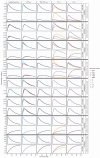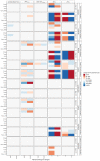Impact of CNS Diseases on Drug Delivery to Brain Extracellular and Intracellular Target Sites in Human: A "WHAT-IF" Simulation Study
- PMID: 33451111
- PMCID: PMC7828633
- DOI: 10.3390/pharmaceutics13010095
Impact of CNS Diseases on Drug Delivery to Brain Extracellular and Intracellular Target Sites in Human: A "WHAT-IF" Simulation Study
Abstract
The blood-brain barrier (BBB) is equipped with unique physical and functional processes that control central nervous system (CNS) drug transport and the resulting concentration-time profiles (PK). In CNS diseases, the altered BBB and CNS pathophysiology may affect the CNS PK at the drug target sites in the brain extracellular fluid (brainECF) and intracellular fluid (brainICF) that may result in changes in CNS drug effects. Here, we used our human CNS physiologically-based PK model (LeiCNS-PK3.0) to investigate the impact of altered cerebral blood flow (CBF), tight junction paracellular pore radius (pararadius), brainECF volume, and pH of brainECF (pHECF) and of brainICF (pHICF) on brainECF and brainICF PK for 46 small drugs with distinct physicochemical properties. LeiCNS-PK3.0 simulations showed a drug-dependent effect of the pathophysiological changes on the rate and extent of BBB transport and on brainECF and brainICF PK. Altered pararadius, pHECF, and pHICF affected both the rate and extent of BBB drug transport, whereas changes in CBF and brainECF volume modestly affected the rate of BBB drug transport. While the focus is often on BBB paracellular and active transport processes, this study indicates that also changes in pH should be considered for their important implications on brainECF and brainICF target site PK.
Keywords: CNS diseases; blood–brain barrier; brain pharmacokinetics; passive transport.
Conflict of interest statement
The authors declare no conflict of interest.
Figures



Similar articles
-
Using the LeiCNS-PK3.0 Physiologically-Based Pharmacokinetic Model to Predict Brain Extracellular Fluid Pharmacokinetics in Mice.Pharm Res. 2023 Nov;40(11):2555-2566. doi: 10.1007/s11095-023-03554-5. Epub 2023 Jul 13. Pharm Res. 2023. PMID: 37442882 Free PMC article.
-
Drug Distribution in Brain and Cerebrospinal Fluids in Relation to IC50 Values in Aging and Alzheimer's Disease, Using the Physiologically Based LeiCNS-PK3.0 Model.Pharm Res. 2022 Jul;39(7):1303-1319. doi: 10.1007/s11095-022-03281-3. Epub 2022 May 23. Pharm Res. 2022. PMID: 35606598 Free PMC article.
-
Exploring Kp,uu,BBB values smaller than unity in remoxipride: A physiologically-based CNS model approach highlighting brain metabolism in drugs with passive blood-brain barrier transport.Eur J Pharm Sci. 2024 Dec 1;203:106883. doi: 10.1016/j.ejps.2024.106883. Epub 2024 Aug 22. Eur J Pharm Sci. 2024. PMID: 39181172
-
Understanding the Blood-Brain Barrier and Beyond: Challenges and Opportunities for Novel CNS Therapeutics.Clin Pharmacol Ther. 2022 Apr;111(4):758-773. doi: 10.1002/cpt.2545. Epub 2022 Feb 27. Clin Pharmacol Ther. 2022. PMID: 35220577 Free PMC article. Review.
-
Hypoxic Stress and Inflammatory Pain Disrupt Blood-Brain Barrier Tight Junctions: Implications for Drug Delivery to the Central Nervous System.AAPS J. 2017 Jul;19(4):910-920. doi: 10.1208/s12248-017-0076-6. Epub 2017 Mar 28. AAPS J. 2017. PMID: 28353217 Free PMC article. Review.
Cited by
-
In Vitro to In Vivo Extrapolation Linked to Physiologically Based Pharmacokinetic Models for Assessing the Brain Drug Disposition.AAPS J. 2022 Jan 13;24(1):28. doi: 10.1208/s12248-021-00675-w. AAPS J. 2022. PMID: 35028763 Free PMC article. Review.
-
Prediction of the Extent of Blood-Brain Barrier Transport Using Machine Learning and Integration into the LeiCNS-PK3.0 Model.Pharm Res. 2025 Feb;42(2):281-289. doi: 10.1007/s11095-025-03828-0. Epub 2025 Feb 10. Pharm Res. 2025. PMID: 39930309 Free PMC article.
-
Interspecies Brain PBPK Modeling Platform to Predict Passive Transport through the Blood-Brain Barrier and Assess Target Site Disposition.Pharmaceutics. 2024 Feb 4;16(2):226. doi: 10.3390/pharmaceutics16020226. Pharmaceutics. 2024. PMID: 38399280 Free PMC article.
-
'Comprehensive review of emerging drug targets in traumatic brain injury (TBI): challenges and future scope.Inflammopharmacology. 2024 Oct;32(5):3271-3293. doi: 10.1007/s10787-024-01524-w. Epub 2024 Jul 17. Inflammopharmacology. 2024. PMID: 39023681 Review.
-
Strategies for Drug Delivery into the Brain: A Review on Adenosine Receptors Modulation for Central Nervous System Diseases Therapy.Pharmaceutics. 2023 Oct 10;15(10):2441. doi: 10.3390/pharmaceutics15102441. Pharmaceutics. 2023. PMID: 37896201 Free PMC article. Review.
References
-
- Loryan I., Sinha V., Mackie C., Van Peer A., Drinkenburg W.H., Vermeulen A., Heald D., Hammarlund-Udenaes M., Wassvik C.M. Molecular properties determining unbound intracellular and extracellular brain exposure of CNS drug candidates. Mol. Pharm. 2015;12:520–532. doi: 10.1021/mp5005965. - DOI - PubMed
-
- Ketharanathan N., Yamamoto Y., Rohlwink U.K., Wildschut E.D., Mathôt R.A.A., De Lange E.C.M., De Wildt S.N., Argent A.C., Tibboel D., Figaji A.A. Combining Brain Microdialysis and Translational Pharmacokinetic Modeling to Predict Drug Concentrations in Pediatric Severe Traumatic Brain Injury: The Next Step Toward Evidence-Based Pharmacotherapy? J. Neurotrauma. 2019;36:111–117. doi: 10.1089/neu.2017.5588. - DOI - PubMed
-
- Bouw R., Ederoth P., Lundberg J., Ungerstedt U., Nordström C.-H., Hammarlund-Udenaes M. Increased blood–brain barrier permeability of morphine in a patient with severe brain lesions as determined by microdialysis. Acta Anaesthesiol. Scand. 2001;45:390–392. doi: 10.1034/j.1399-6576.2001.045003390.x. - DOI - PubMed
LinkOut - more resources
Full Text Sources
Other Literature Sources
Miscellaneous

